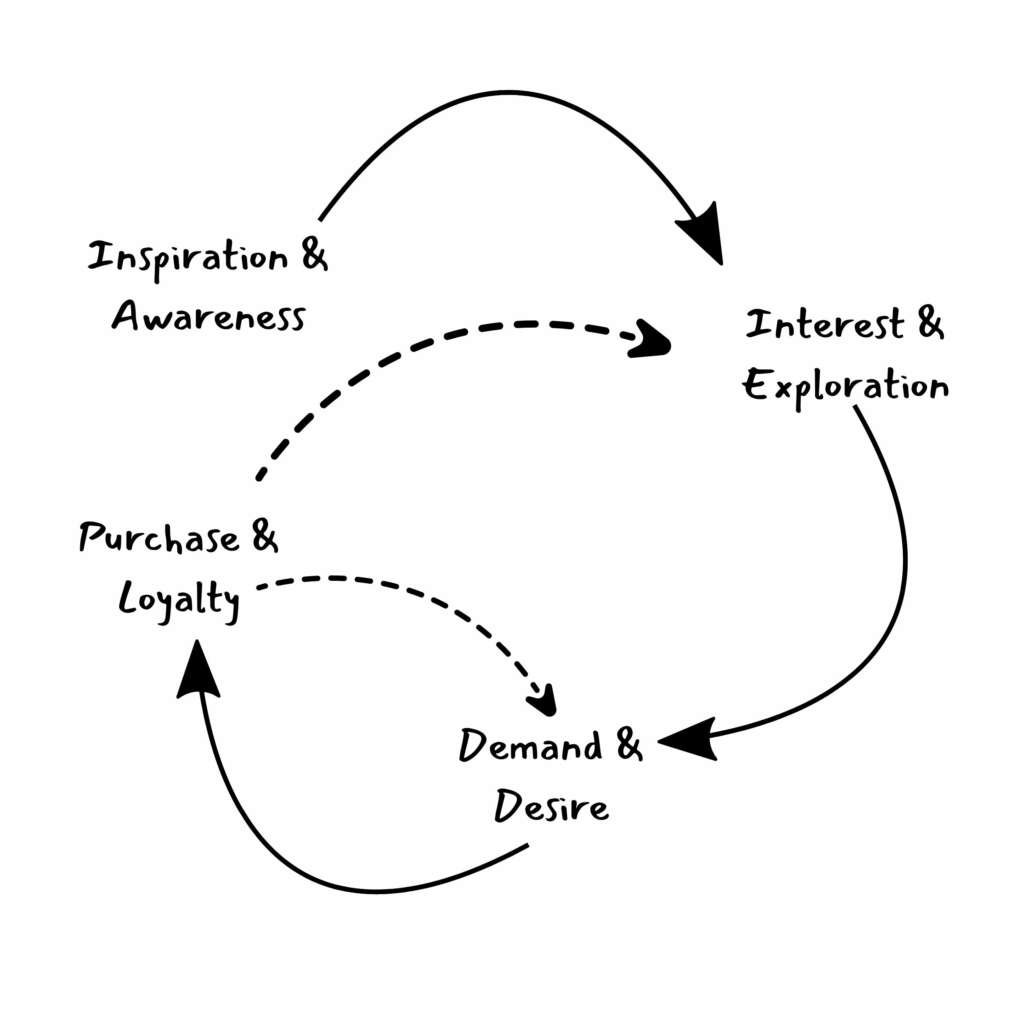Marketing plays integral role in the success of a business and in driving demand — we see it in the front-end/top of funnel stage as well as the purchase stage/bottom of the funnel.
A key marketing strategy is to engage with your audience to inspire and bring awareness to what you do, drive interest and exploration of your offerings, create demand and desire to make a purchase, and ultimately to become a loyal customer.
We call this the demand loop.

Inspiration and Awareness
Marketing can be done to bring awareness to a service or product offering. there are many ways to do that — content marketing, social media, working with influencers, buying ads or running promotions, doing activations at events, creating storytelling videos or photo essays, sponsoring events, going on podcasts, and more. The list goes on and on.
Marketing can also inspire someone to change or think differently. One example for this is how Impossible and Beyond Meat inspired people in their early marketing to think of a diet beyond the standard American diet which is highly reliant on meat. Another example is Silk soy milk, going beyond dairy. Nike shoes inspires people by using highly relevant athletes to promote their brand — most recently Caitlin Clark when she broke the all-time men and women’s NCAA basketball scoring title.
Interest and Exploration
Once awareness is earned, it’s the consumer’s opportunity to explore the offerings and build interest. How can marketing support that? Marketing supports it through creating educational content, nurturing the consumer via targeted remarketing ads, nurture email campaigns, creating engaging content on social, and more.
Demand and Desire
With awareness and interest/exploration managed, we move into building demand and desire. Our goal is to give the audience what they need in order to make a purchase or inquiry decision on their own accord — think of it like asking for your product by name. How many of us will order a Coke or a Pepsi at a restaurant because that’s what we prefer? Same game here.
Purchase
Now we’re at the purchase point. How can marketing support this? This is a big question and really there are so many variables here so we can’t get too deep into it — so much depends on your go to market strategy, type of product, how people buy, and others. But let’s break it down into simple examples:
- B2B sales cycle: marketing can support the sales effort by collaborating with sales team (remember The Revenue Team is a coordinated group of marketing and sales people working closely together) to create the appropriate assets for each stage of the buying journey — from initial contact all the way to close. This could mean proposal templates, case studies, product decks/brochures, testimonials, or a number or other assets that fit your need.
- B2C e-commerce: implementing tools and strategies to capture immediate interest from your audience is a strategy we see a lot — think offering a discount in exchange for an email address, a one-time discount on a product bundle, etc.
- SaaS: Offer a simple onboarding or trial/freemium model to convert users to a basic product offering to show value and work on converting to paid down the line. This usually means a coordinated effort via email marketing to onboard and show the customer the features they may be missing on the free version, or a collaboration with the sales team on what an appropriate plan and cadence could be to work on selling them on a more one-to-one level.
- In Store Consumer Products: Activation campaigns like offering free samples or demos at target retailers are a good way to introduce your product to a new subset of customers who may have never seen you before. Activations also allow you to convert someone from product-unaware to aware to customer in one shot.
Loyalty
Ok, now they’ve purchased. With that trigger it’s time to convert that purchase into loyalty. How does marketing support this? There are tons of ways!
- SaaS companies offer discounts to pay for a year in full – it ensures they stick with the product in the long run and allows you to build stickiness
- E-commerce companies offer subscription plans to get the product shipped on a set schedule
- B2B services may have “white space” campaigns to educate their customers on other offerings they may find value in.
Building demand isn’t a one-time thing. It’s a loop starting from problem/product-unaware, pushing into awareness and exploration, and something that helps a customer make a purchase decision (and a repurchase decision).
It’s time marketers move away from the “funnel” which is more indicative of a one-time purchase and onto the demand loop which is all about full cycle relationship building and loyalty.
